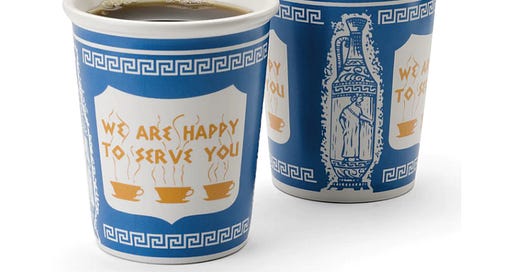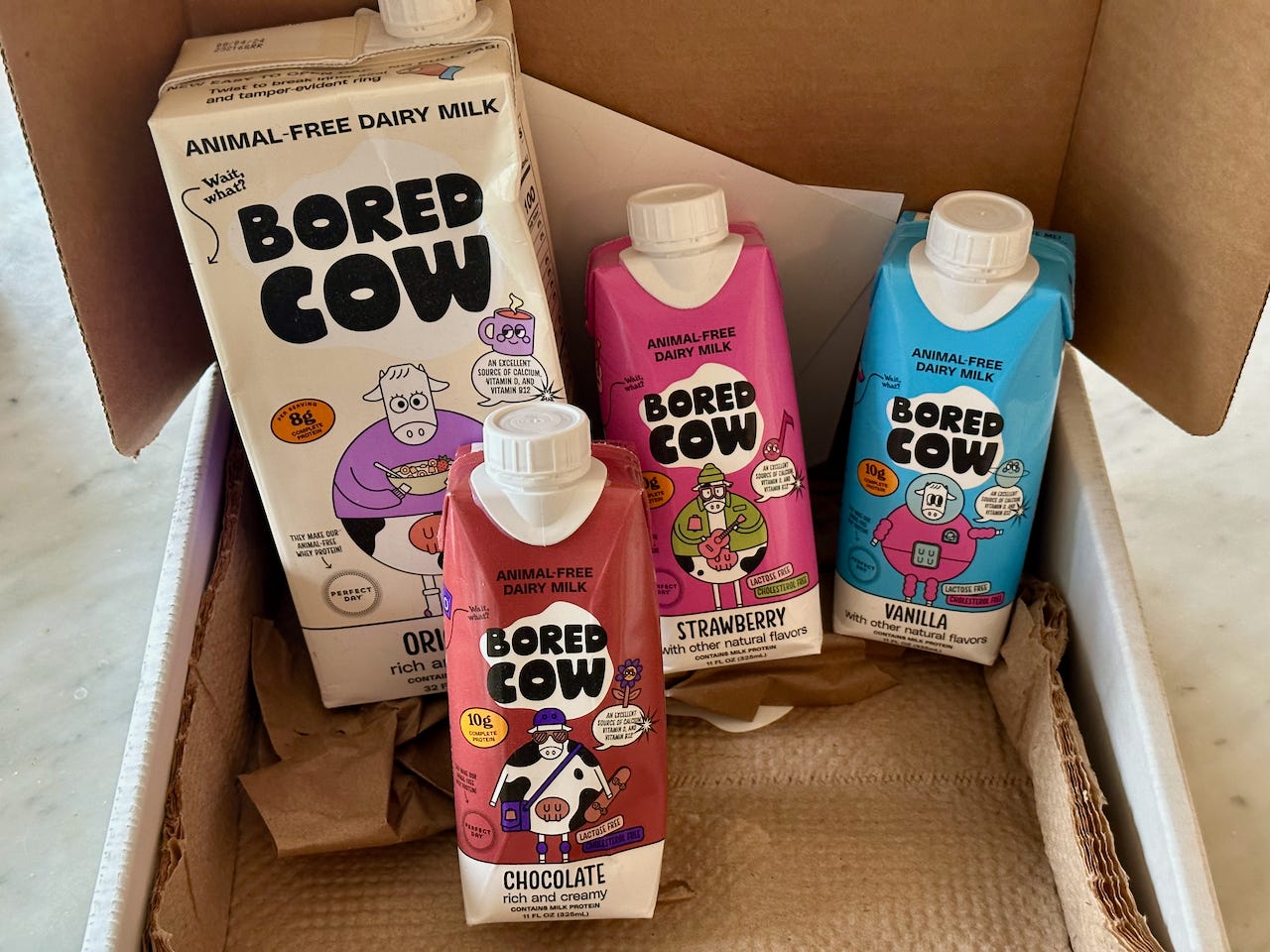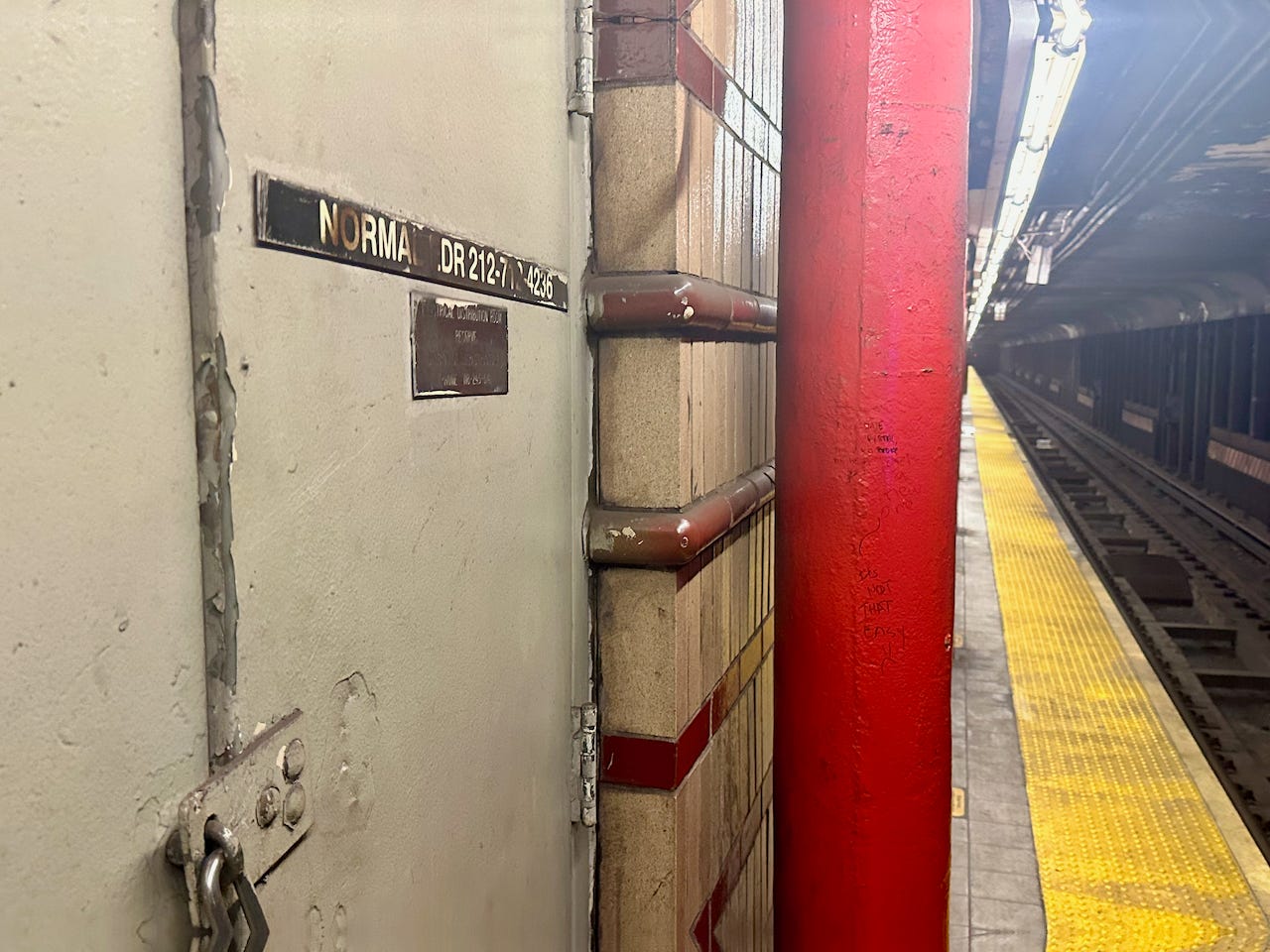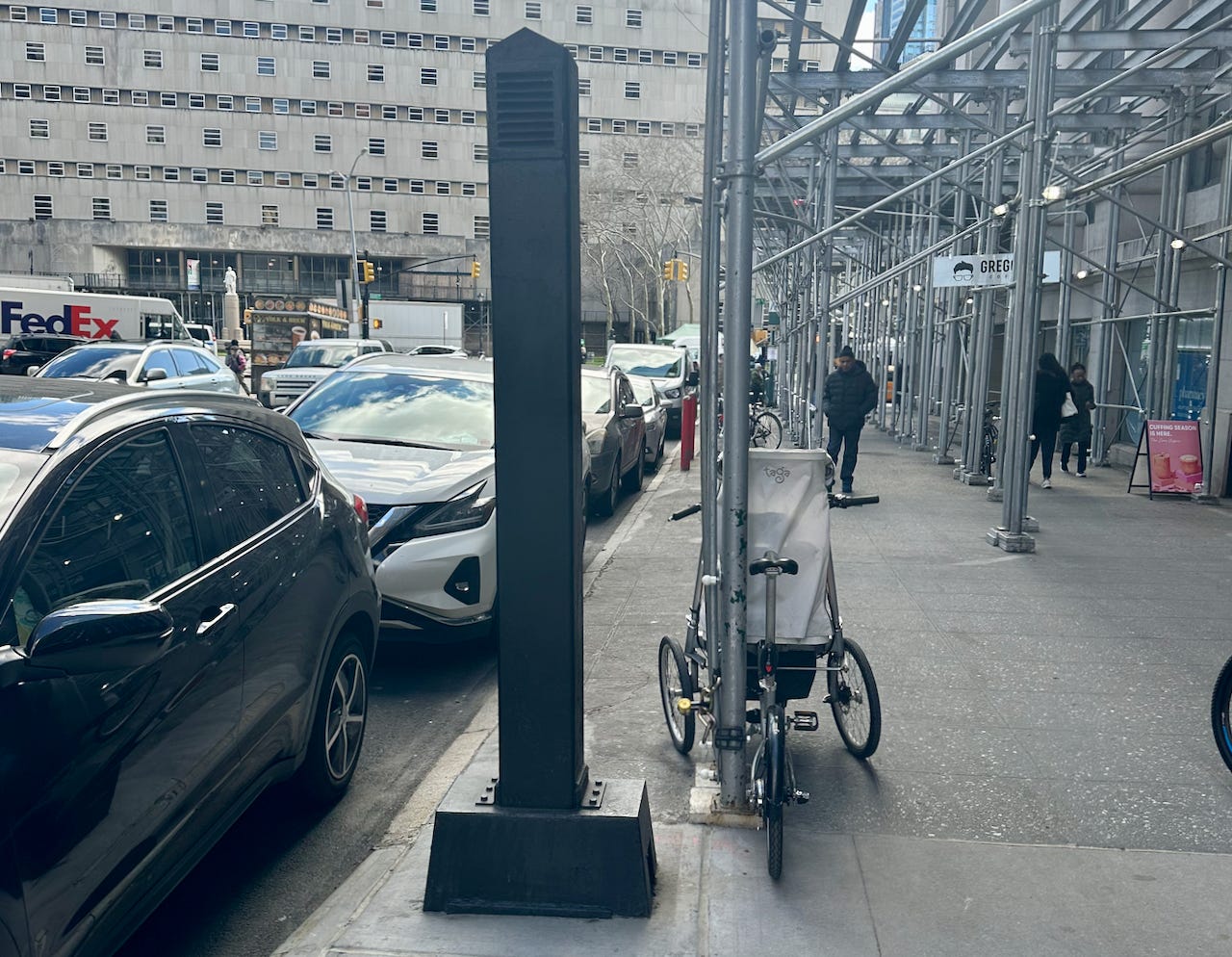The Vanishing Cup That Won't Stop Being Famous!
Plus! Animal-Free Dairy Milk!! A Street Furniture Mystery!!!
Hello everyone,
Welcome to Issue #111 of CAFÉ ANNE!
So the star of last week’s edition was clearly Bill the ex-con, who, in our latest round of Senior Citizen Roulette, told his tale of teaching fellow prisoners how to read.
“I love the story of the guy who read Viktor Frankl and was inspired to be a teaching assistant in prison. He is so inspiring!” wrote LH Reader in the comments. “He didn’t just read the book, he took it to heart and lived it. He probably changed more lives behind bars than many of us will on the outside, and I salute him for it.”
I also got several comments suggesting I try a new twist on Senior Citizen Roulette, the game I invented in which I pose reader-submitted questions to random seniors found on the streets of NYC.
“I am a newcomer to the Café, so am wondering if you have a Teen Citizen Roulette (at the other end of the age spectrum)?” asked reader Daniel in Boston. Another reader suggested “Gen-Z Roulette.”
So how about it? Should I try the game with NYC teens? With Gen-Zs? With feral, outer-borough raccoons? Your wish is my command, although not really.
Moving on, my visit to NYC CoffeeFest, recounted in Issue #109, just keeps giving. In the story about the trade show, “I Saw the Future of Coffee and I’m Buzzing!” I briefly mentioned an exhibitor offering “Animal-Free Dairy Milk.” What?
Turns out, reader Eden in Brooklyn works for the NYC company, Bored Cow, that makes the milk. She spotted the mention and offered to send a sample. Of course I said yes!
Eden shipped me a quart of the “original” flavor milk along with 8-oz samples of the chocolate, vanilla and strawberry versions. I immediately tore the cap off the carton and took a big swig straight from the box, because that’s just how crazy I am. Hey there, it tasted a lot like milk!
I also tried it in my coffee. This was a disapointment, but I’m a loyal half-n-half lady. Bored Cow is closer in fat content to 2% milk, so it never had a chance.
How is it “Animal Free”? It’s made from dairy protein (aka whey) produced in a lab through fermentation. No cows involved, just bacteria. Weird! But cool!
Moving on, huge Seward’s Day shoutouts to this week’s newest paid subscribers Ann T., Jeremy M., Raquel U., Linnean D, Brooklynite282 and Leonard G. That’s enough $$$ for a one-way flight from JFK to Anchorage! I may never return. Meanwhile, your support helps keep the newsletter free for everybody else. Thank you!
I am very excited for this week’s issue, of course. We’ve got two fun mini features about things inspired by readers. Please enjoy.
Regards!
Anne
ASK CAFÉ ANNE
What’s Up With This Mystery Tower?
I recently got one of my favorite types of reader emails—a request to solve a NYC mystery! This one was from Jordan in Downtown Brooklyn who wrote:
“I live off Fulton Mall (not the mystery, but “why” is a fair question) and saw this random pole in front of the Macy’s. A friend of mine who used to work for the MTA said he’s often wondered and doesn’t know. Is it a speaker? A vent? Google reverse search showed me a number of very nice municipal green light poles, but none were quite this. Appreciate any brain power you contribute to this if you so choose!”
She kindly attached a photo of the mystery object:
Hmmm. Where to start? I could query every agency in the city, but that would mean about fifty emails. Instead, I decided to try some crowd sourcing. I posted the photo to r/nyc, the NYC subreddit, with the straightforward subject line, “What is this?”
I got more than 40 responses within a few hours. My favorite: "It's a Macy's. A lot of big department stores don't do a lot of business thanks to the move to online shopping and big box stores undercutting them, but some still exist."
Hahaha!
Others replied:
“A time machine.”
“A skyscraper for ants.”
But the vast majority agreed: it is some sort of vent. For the sewer, a gas line or perhaps the subway.
I next stopped by the tower in person. It was larger than it appeared in the photo, perhaps twelve feet fall, hollow and made of metal. There were vents at the top and bottom. I sniffed the bottom vent. No odor, so it probably wasn’t a sewer or gas vent. This left the subway line under Fulton Street.
Sure enough, I spotted an entrance to the Hoyt Street stop of the 2/3 train on a nearby corner. I counted the number of paces to the subway entrance, paid the fare and backtracked an identical number of steps along the train platform. This brought me directly to a dented metal door:
I wanted to peek inside, but it was bolted shut. I continued along to the end of the platform, where it narrowed to a two-foot ledge. And guess what I found? Two more mystery doors, both fastened with padlocks!
One was labeled “Electrical Distribution Room,” and bore two phone numbers. The second was labeled "Station Department Brooklyn South.” Hmm. The vent could have been situated over any of the three rooms.
I was walking home, day-dreaming about what might be behind those doors, when I spotted an extremely interesting sight on Montague Street near Brooklyn Borough Hall—another tower!
This tower was similar to the first, but shorter, with no vent at the bottom. I’d passed it perhaps a thousand times without noticing. Are these towers all over the city?
This one was also located near a subway entrance, so I counted my paces east, went down the stairs, passed through the turnstile and took 50 steps west along the mezzanine-level passage leading to the R train.
This brought me to another set of metal doors. One was labeled “HVAC MECHANICAL ROOM.” Another, labeled, “STATION ENVIRONMENT,” bore the same phone number as one of the doors in the other subway station!
I felt I’d solved the mystery! The towers on the street, I surmised, are venting underground equipment rooms that generate a lot of heat. But how to confirm?
For decades, I’d noticed the phone numbers on the mysterious metal doors throughout the subway system. Finally, I had an excuse to call!
Dialing the first number got me a man who said he worked for the MTA’s HVAC division. Unfortunately, I could not dissuade him from the idea that I was a fellow MTA worker who needed help getting into the room. I was dying to get into the room, of course, but I knew this would get the man in trouble, so I moved on.
The next number got me a fellow who identified himself as a supervisor. Alas, the sound quality on this call was so bad I got nowhere.
The third call was my favorite. A man answered after two rings: “Eddie!”
“Hi Eddie! This is Anne!” I said.
I explained why I was calling.
“I don’t want to cut you off,” said Eddie, cutting me off, “but the number on that door, it was just issued to me—I'm in payroll!”
“Oh no!” I said.
“It’s on doors all over the system!” Eddie wailed.
“Are getting a lot of calls like this?” I asked.
“Yes, I am,” said Eddie.
“I hope they take care of that,” I said.
“Thank you,” said Eddie.
So there you go. I was out of numbers.
I emailed the MTA press office after that, attaching photos of both towers. Hopefully they will confirm my conclusion, and I will feel like a WINNER. Meanwhile, readers, if you see one of these towers in your part of town, please do your own investigation and let me know what you find!
Have a NYC mystery for CAFÉ ANNE? Please email your query to annekadet@yahoo.com.
DEPT. OF PAPER CUPS
The Vanishing Cup That Won’t Stop Being Famous
Can a paper cup be famous? Only in New York!
A while back, a reader’s comment on one of my many stories about NYC and coffee got me thinking about one of those vanishing icons of New York City life—the Greek paper cup.
"Loved this piece! Made me miss the days of toasted buttered cart bagels and coffee in the blue Greek cup. Good memories," wrote Amy.
I knew just what she was talking about. "Now you can buy a ceramic version of those blue Greek cups in hipster gift shops," I replied, "but you never see the paper version out in the wild. Sad!"
When Amy said she had no idea they'd discontinued the paper cups, it got me wondering. Had they?
"You know what?" I wrote. "I'm going to do a story looking into whether anyone is still making the paper version, and who is buying them."
Reader, I got my answer. But first, a little history—because it's a fun story!
The saga started in 1963 with a fellow named Leslie Buck, a marketing exec for the Connecticut-based Sherri Cup Company.
Back then, the only NYC businesses selling coffee-to-go were diners and pushcarts run by Greek immigrants.
Mr. Buck figured a cup design appealing to these business owners would be a big seller, so he took a standard 10-oz paper cup and slapped a bunch of random Greek signifiers on it: the blue-and-white colors of the nation's flag, a Grecian key border and a weird little drawing of a Greek urn. Most famously, the cup carried the motto, "WΣ ARΣ HAPPY TO SΣRVΣ YOU" with the Greek letter "Σ" replacing the Latin "E."
Greek diner and cart owners went nuts for the design. Over the next few decades, Sherri sold millions of these cups to coffee vendors all over NYC. The cup graced the cover of the Manhattan phone book and is on display at MoMA, which sells a ceramic version in its gift shop.
When I moved to NYC in the 90s, coffee was still served in these cups in many bodegas, bagel shops and diners—Greek or not. According to Wikipedia, sales reached their peak with 500 million sold in 1994. (Can this be possible? That’s 68 cups per NYC resident! So no.)
But now, for the life of me, I can't recall the last time I saw a coffee to-go served in one of these cups. Are they totally extinct?
It took ten seconds to Google the answer. The aptly-named "NY Coffee Cup," a small business based in Ithaca, New York, offers the cup in cartons of 100 for $44 or 1000 for $279.
"We sell a lot of these cups," said co-owner Michael Turback, when I got him on the phone last week. "And we send them all over!”

Mr. Turback, who founded the company with his brother, told me the rest of the story.
The Sherri Cup Company was eventually acquired by the much larger Solo Cup Company, which was in turn bought by Dart Container in 2012.
By that time, said Mr. Turback, sales of the famous Greek cup had fallen sharply, thanks to all the Dunkins, Starbucks and indy cafés crowding the NYC coffee landscape with their own cup designs. It was discontinued twelve years ago.
"These huge companies decided, ‘This is just some regional pain-in-the-neck,’” he said.
Mr. Turback, a former restauranteur who grew up in New Jersey just outside NYC, had an online business selling NYC-themed gift merchandise. He had been buying the cups wholesale to resell on his retail site.
When the cup was discontinued, the Turback brothers decided to have it produced for their own business. The cup design is still owned by Dart Container, and NY Coffee Cup has the exclusive license to manufacture and sell it. (You can, of course, buy cheap knockoffs on Amazon.)
Mr. Turback is not sure exactly how many cups he sells a year, but it's a lot! They're made in Chicago, he said, and he has a truckload of 50,000-70,000 cups delivered to his warehouse 4-5 times a year. "You do the math," he said.
So who’s buying the cup? Oddly, they get very few orders these days from NYC coffee shops.
"If I had my own café, I would totally be using these cups," I told him.
"Well, but you won't," said Mr. Turback. "I'll tell you why you won't. Because we pay a premium to get these things custom-made. And what we pay to get them made, and what we pay to transport them, makes them sell for probably close to twice what you can buy a typical paper cup for."
"The other reason is, this is a ten-ounce cup," he added. "People drink coffee in bigger cups now."
True! A small coffee at Starbucks, for example, is twelve ounces—too big if you ask me. Ten ounces is exactly the right size!
NYC businesses do buy the cups to serve higher-margin menu items, said Mr. Turback. A Brooklyn bar uses them to serve a specialty cocktail, for example, and a Greek frozen yogurt chain uses them for soft-serve.
Another big market: ex-New Yorkers who want a piece of home. A Philadephia company owned by former New Yorkers buys cups by the case for its employee break room, for example. An artist used them to make a lamp.
Then there's the film and video production companies who want the cups on hand to establish that a scene is taking place in New York City. In that way, the cups are a lot like Times Square and yellow taxis—still used to symbolize NYC even though they’re no longer used by actual New Yorkers.
They’ve appeared in just about every NYC cop show, in movies such as Goodfellas and Spiderman and in many episodes of Mad Men, of course.
"It's the film and the TV that keep the interest in the cup up enough that we continue to sell it," said Mr. Turback. "Our sales are very strong and consistent."
The Turback brothers no longer run a NYC-themed merchandise company—they long ago turned their efforts to a newer enterprise, History Company, selling history-inspired gifts. NY Paper Cup now operates as a stand-alone online shop. But it's profitable enough to keep going.
And it's also about the joy the business brings others, said Mr. Turback: "We can't let go of the cup! When people find them, they're so happy. There's so much goodwill in operating this relatively small section of what we do. We love selling them!"
CAFÉ ANNE is a free weekly newsletter created by Brooklyn journalist Anne Kadet. Subscribe to get the latest issue every Monday!





















I LOVE another issue of CAFE ANNE!
How anyone can bat 1,000 with a fun and interesting issue every week is a miracle and should be in Guinness Book of World Records.
More importantly I choose to believe that in 1994 NYC residents used 68 Greek coffee cups per year.
Thank you!!!
My kid has a giant stuffie version of the blue Greek coffee cup! Somehow, it manages to be famous even among the too-young-for-coffee set.